Lisbon Crooks are small surfboard shapers from Portugal’s capital and bring back the good ol’ times when surfing still was punkrock. An edgy, alternative way of life, that wasn’t about pleasing everybody or earning shitloads of money. That stands for being true to yourself, loving what you do and share the stoke with a bunch of saltwater-crazy buddies. With slogans like “we are not surfers, we are wave lovers” the Crooks are distancing themselves from today’s mainstream with its billion-dollar surf industry, big brands, uber hip people and elitarian line ups. Instead, they just make fantastic boards and celebrate their surf counter culture.
We met Mr. Benga and Alfredo – the two tattooed and very friendly Lisbon Crook founders – several times in Portugal. To chat, to drink, and to shape what is now one of our favorite boards. The guys have different names, but prefer using alter egos, because, as they say, shapers shouldn’t take themselves too seriously. Luckily, we still could convince them to do this interview and tell us more about their very entertaining story – from the early (not always legal) beginnings to the feisty way they do business today.

Enjoying surf life, not stereotypes: (1) Alfredo and (2) Mr. Benga from Lisbon Crooks
(1) Lisbon Crooks: From Kooks to Surfboard Shapers
Hi guys, great to have you! Tell us a bit more about Lisbon Crooks – what’s the story behind your brand?
Mr. Benga: I started surfing really late, in my 30s, after I couldn’t play football anymore because of injury. That was over 10 years ago. I remember that I looked for a surfboard, but could only find the “cool” surf shops, with expensive boards and people working there being kind of intimidating. So I asked my friend Alfredo to shape me a surfboard by hand – it was rather bad, a super fat and crooked potato 😉 I couldn’t offer him money, but build his website instead. That was the beginning of the Lisbon Crooks.
The Lisbon Crooks were founded with the idea of making surfboards for friends and people that didn’t feel like stereotypical surfers. The truth is that the surf industry is very narrow, and we are all a lot more than that!
ALFREDO, LISBON CROOKS
Alfredo: There was nothing that really represented the way we see things and look at surfing. With Lisbon Crooks, we wanted to give an opportunity to all kinds of people to get a surfboard for an affordable price – and just like they imagined it. We came a long way since those early years, but the feeling and the passion for the ocean and doing things different is still the same. Today we are shaping our surfboards in a professional surfboard factory at the Costa Caparica – together with a team that has over 30 years of experience.
Lisbon Crooks: How did you come up with that very particular name?
Alfredo: Our Australian friend Jamie just called me that, because of an old story about me as a teenage kid. I grew up in a neighborhood called Casal Ventoso, that doesn’t exist anymore. It was more or less like a slum in the outskirts of the city of Lisbon. We used to play football all day, but somehow, I had this obsession to the ocean. The first time I saw someone riding a wave, I knew I had to do it too.
Having no money for a surfboard, my only thought was going to the “rich kids town” and get one “borrowed” – I was 13 years old and not a particularly good boy. So I took the train to Cascais and came back home with a board under my arm. I covered it up in paint and went to the beach again. That was the beginning of the Lisbon Crooks. Nowadays, I can’t even steal an orange on the grocery store anymore 😉
ALFREDO, LISBON CROOKS
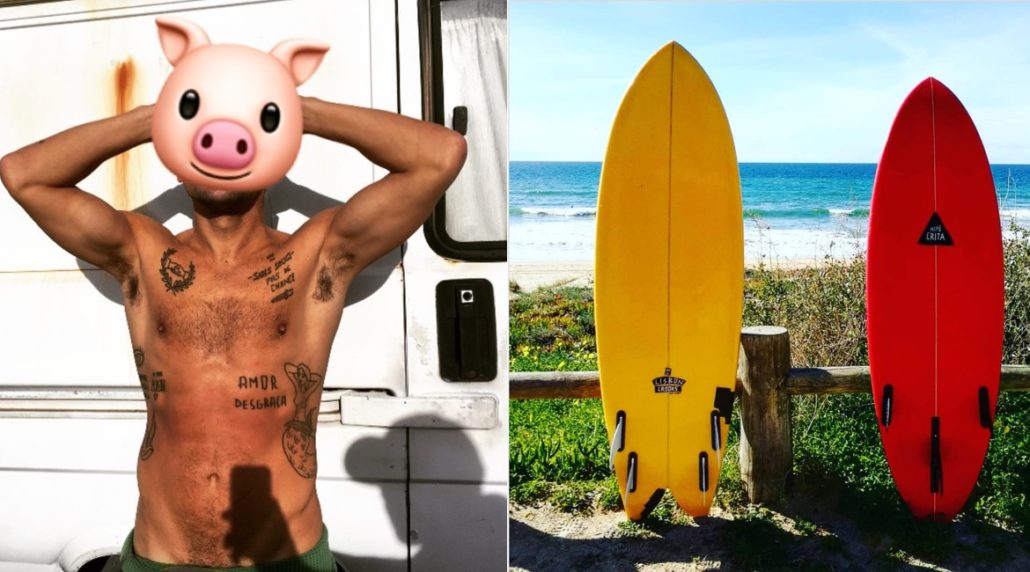
Busted: The only thing Alfredo is getting caught for today is tanning and surfing
Besides you two guys and your colleagues in the surfboard factory, who else is part of Lisbon Crooks?
Mr. Benga: We seem to make friends easily 😉 No honestly, we like to meet new people and build relationships. That is why we have lots of buddies and ambassadors around the globe. For example, one guy in Japan invited Alfredo over after only one encounter and showed him everything. Later we reciprocated by being equally hospitable in Portugal. With the Germans, the “Hamburg connection” is especially strong: First Tim from Kb. Klaubauter introduced us to the Saltwater Shop, then we organized a surf retreat together in Lisbon, and in 2019 met at the Vans & Waves Surf Festival in Denmark.
Alfredo: Everyone who has a surfboard or a T-Shirt from the Crooks is part of the gang. Crooks are everywhere and they love wine!
What do you love about surfboard shaping and doing custom shapes?
Alfredo: The possibility of making someone else’s dream about a surfboard come true. That was what motivated us from the beginning, and it’s still true!
It always makes me happy to make a surfboard for someone that dreamed about it. Even if it’s a pink surfboard with yellow dots, it will be definitely the best surfboard in the world for that person! This is why we do it. To know that for the customer, there will be no better feeling than putting their dream board in the water for the first time!
ALFREDO, LISBON CROOKS
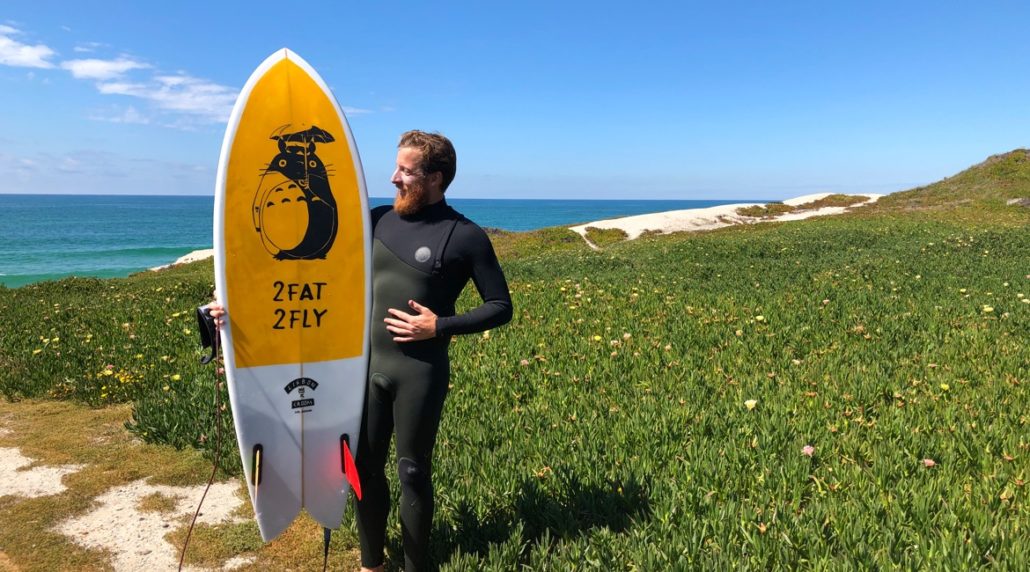
Chris aka Mr. Meerdavon after his first session with the Lisbon Crooks fish
You cannot live from Lisbon Crooks alone (yet) and also have other jobs, like freelance design or tourism tours. How is the business developing?
Alfredo: We manage doing some things besides Lisbon Crooks, helping others with their own projects. Gladly we have friends and people that believe in what we are doing, and they have been supporting us a lot. We sold a few more boards and some silly t-shirts that our friends were always asking for. The truth is that we are very happy, because we are doing what we believe in, and everyone who buys from us is helping to achieve that feeling. We thank you and love you all!

Alfredo loves making surfboards – and surfing them as well
Mr. Benga: We are selling a handful of boards per month, mainly to foreign people from Germany and other countries. It’s tough to sell our surfboards in Portugal. On a testing festival, one local guy observed the boards, estimated the quality and then bought quietly. What I mean by that is that Portuguese people are not the biggest talkers, which makes giving shopping advice more difficult.
I also have the impression that some locals don’t value Portuguese work enough. They rather go for famous brands from America and Australia. That’s how I came up with the slogan “We are not from California” – after having noticed that one of the more prominent Portuguese shapers proudly presented a big and expensive shaping machine from the USA. It was funny when a handicapped surfer – whom we support with boards – wore a tshirt with exactly this slogan when he went to a surf contest in the USA 😉
BENGA, LISBON CROOKS
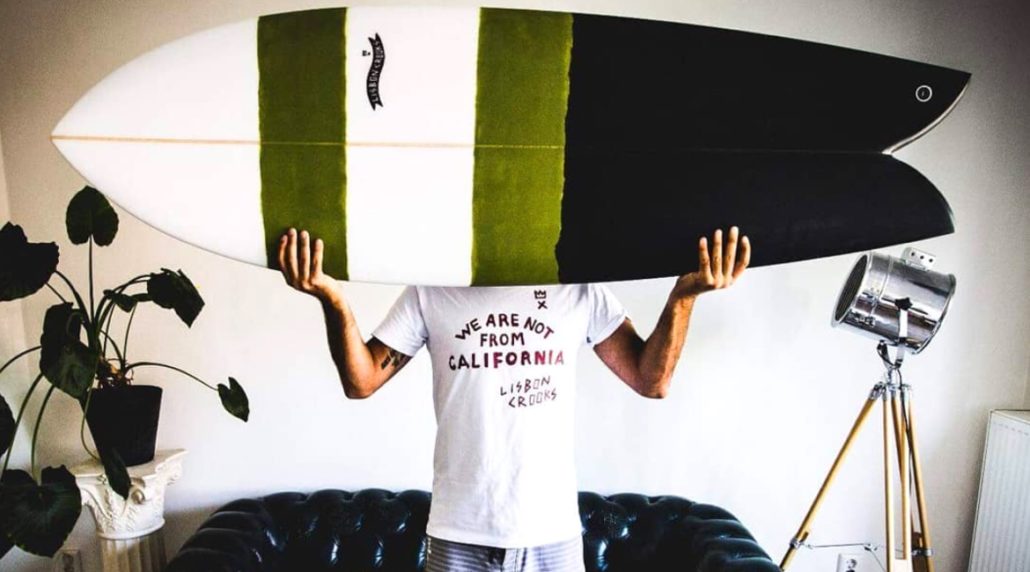
Mr. Benga: Support especially amongst local businesses is really important. For example, we give out surfboards to friends in surf houses at the Costa Caparica or on the Azores – for us it’s marketing, and their guests have good rides.
(2) Lisbon Crooks: Bringing honesty back to surfboard making
Sometimes you say online “our surfboards are the worst” which doesn’t sound like the best sales argument. Can you explain your intentions behind this funny slogan?
Alfredo: Well, the truth is that shapers and most of the surf industry is all about big egos and who is the best. For us, by saying we make the worst surfboards, we are also saying that we are not part of this surf industry. Fuck egos and who is the best! I normally say that we make surfboards for the smart and interesting people around.
We are very happy to know that there are some cool people out there, that are buying a surfboard and not a big penis.
ALFREDO, LISBON CROOKS
Benga: The Crooks stand for an alternative approach to surfing. A counter culture that doesn’t want to take surfboard shaping too seriously, or glorify it with big marketing talk like big brands usually do. It’s only a surfboard, for god’s sake, and everybody could shape that! In the end, a board is a board, and shapers all do more or less the same. The big shots let customers often pay an obscene amount of money only for their name, even though they use cheap blanks and produce in China or Taiwan. That’s vulgar!

You like to make fun of big surf brands and even have a board called “Hipocrita” – a clever pun on a very famous competitor model. Why should people go for a smaller brand like yours instead?
Alfredo: Well if you can be with Al Merrick or Hayden, go ahead and make a board with them, and have a beer too! Just don’t get something you think they are making personally, and then wonder when it comes from somewhere else, and they didn’t even know who you are.
Relying on smaller brands, you can actually have a close relation with the people that are shaping your surfboard. And this is what we should aim for, not only with surfboards, but clothing, vegetables, shoes and so on. Especially if a product is coming from someone we don’t even know or can’t see smiling happily when you are getting it from them – shop consciously, shop less and consume less.
ALFREDO, LISBON CROOKS
Alfredo: We don’t want to be a big surfboard brand, because we think that producing and consuming less is the key for ourselves and for the environment. The planet is full of shit already! We don’t believe in stocks, and we never wanted to produce too many boards, or more than you need. So we just do custom surfboards by order and only have ten surfboards available for test, rent and exchange – as well as some second hand boards.
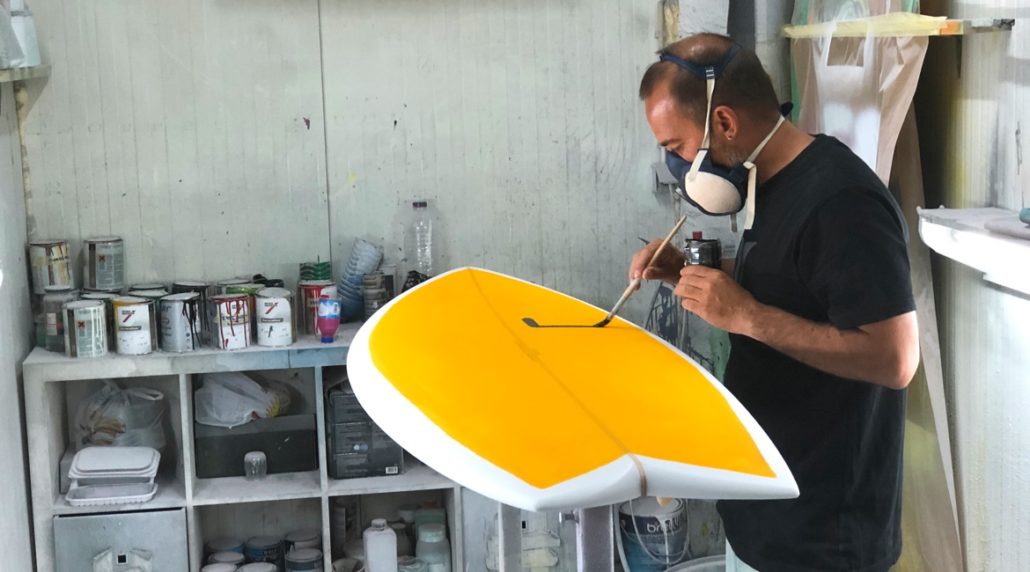
Mr. Benga painting our new fish – by hand and free style
You seem to like wild paint and graffiti designs as part of your surf counter culture. Tell us where that comes from!
Alfredo: Growing up in the 80s and 90s, I think that was a reality for all of us: Spray cans, walls and trains. Our boards reflect a bit of that “just do it” attitude” – quick and cool. We don’t think too much about painting our boards, it just comes with the natural feeling of putting some color on them. But I have to admit that wine influences more than graffiti nowadays 😉
Mr. Benga: When we grew up in poor neighborhoods in Lisbon, it was still common being robbed and fight in the streets. Maybe that’s also explaining a little bit where the “tough guy image” with graffiti and feisty quotes is coming from 😉
Is your design also inspired by music? To make a guess, I would say it’s punkrock… Right?
Alfredo: We listen to everything, but obviously punkrock influenced us a lot growing up and working. But good Jazz and some classical music are good for the soul, too! We are very eclectic in our music choices and of course, Fado is sometimes also part of our beach soundtrack.
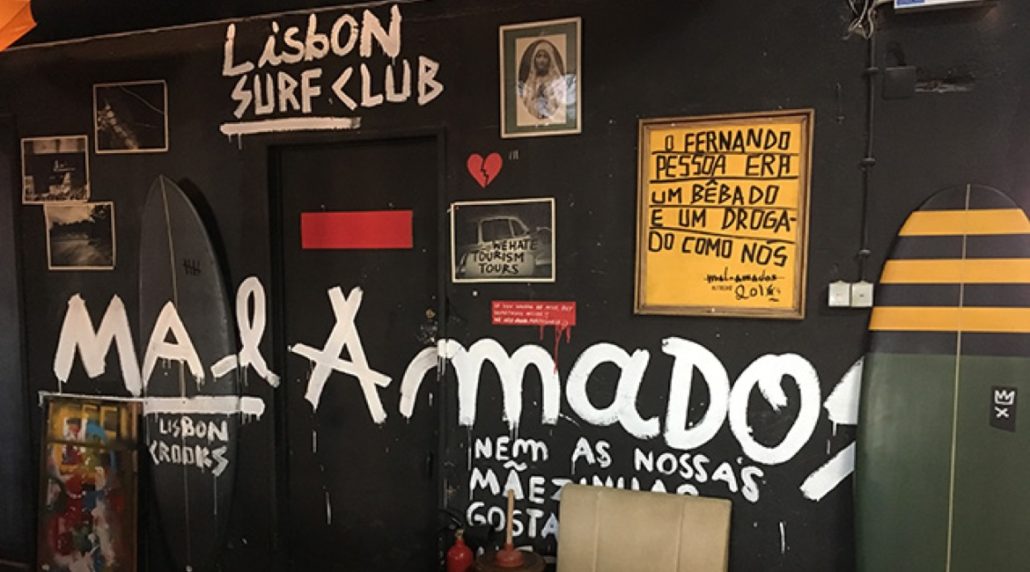
(3) Lisbon Crooks: Surf life and other passions
Apart from being busy with surfboard shaping, how would you guys spend the perfect day?
Alfredo: Starting the day at 7am with a surf session for 3 hours, next go and buy some fresh fish for barbeque for lunch with plenty of wine, followed by a nap outside in the shade. Then afternoon football match at the beach, and a last surf session until the sun goes down. Dinner out at a small Portuguese family restaurant and going for drinks at night. All this with friends, of course! A perfect day for us, that we are making happen quite often.
Once we thought about a name for a new surfboard shape during lunch, and the wine was flowing already for the guys (I am not drinking though). So the model named “Vinasa” was born!
MR. BENGA, LISBON CROOKS
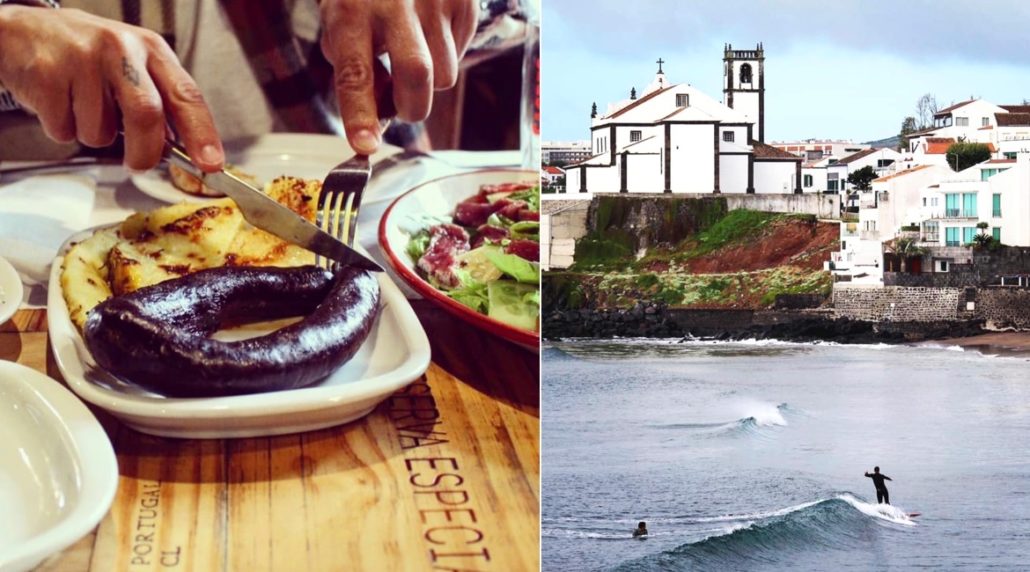
Perfect day in the Crooks universe: Good food and surf, shared with friends
Mr. Benga: Good food is always very important in Portugal, preferably at small places around the corner, with a menu of fish or meat, as well as a nice glass of wine, beer… or in my case, Cola.
You are both from Lisbon, even though Alfredo is living in Porto now. Do you have favorite places to hang out?
Alfredo: Anywhere that has the ocean nearby is a good place to hang out, and in Portugal we can complain about a lot of things, but not about this one. The ocean is our backyard!
Your boards and shirts carry slogans like “surfers are suckers” – a message to the scene?
Alfredo: We really love everyone, but we just wished surfers could think a little bit more. The surf industry is really controlled by big corporations that just push stuff down your throat and take advantage of individuals to sell you the lifestyle. By using slogans like “surfers are suckers” we want you to stop obeying to commercialism and just think about being yourself when you go out in the ocean.

“I’m not a surfer, I’m a wave lover” states one of your new shirts. What’s the difference between those two?
Alfredo: The first one has a stupid competitive face and is destroying the waves, the second one is smiling while making love to the waves 😉
How do you personally regard the development of the surf scene?
Alfredo: It’s sad that we have more and more performance shortboards in the water. There is more competition happening the line up, and stupid people frequenting the ocean who want to be the next Medina. It sometimes looks like everyone is there to get a good score! We can’t wait for more wave pools to be built everywhere, so those suckers who don’t seem to love the ocean very much can get away from it.
Build more wave pools please, and the ocean will be a better place for wave love making 😉
ALFREDO, LISBON CROOKS

Wave love making: Sometimes it’s fun, sometimes it hurts
Last but not least: What kind of boards to you guys ride?
Alfredo: I love retro shapes in general – anything that rides smoothly.
Mr. Benga: Personally, I don’t like the stereotypical thruster as well, but rather single fins, twin fins or quads. I’m also more the fun guy in the water 😉
Thanks for the interview, Alfredo and Mr. Benga, and also for letting us visit you at the surfboard factory.
If you also want to get in touch with Lisbon Crooks, write them an email, talk via Instagram or meet them at their small concept store in Lisbon’s LX Factory! But before you go – give them a shout, they might be surfing











